14639680 Private David Bennett Jones - Chindit
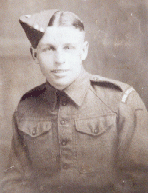 One of seven children, David Bennett Jones was born on 8 May 1924 in Montgomeryshire
in the heart of rural Mid Wales. He attended Llanwnog primary school, and on leaving
school, worked for a while in agriculture. In July 1943, just after his 19th birthday,
he was enlisted into the General Service Corps, and in August of the same year, transferred
to the Royal Welsh Fusiliers.
One of seven children, David Bennett Jones was born on 8 May 1924 in Montgomeryshire
in the heart of rural Mid Wales. He attended Llanwnog primary school, and on leaving
school, worked for a while in agriculture. In July 1943, just after his 19th birthday,
he was enlisted into the General Service Corps, and in August of the same year, transferred
to the Royal Welsh Fusiliers.
Following a spell with 7th Bn South Lancashire Regiment, he was transferred to 1st Bn South Staffordshire Regiment which flew out to Burma in 1944 as part of 77 (Indian) Infantry Brigade which took part in "Operation Thursday" under the command of Brigadier J. M. ("Mad" Mike) Calvert DSO.
"Operation Thursday" was the second Burma expedition of Maj. Gen. Orde Wingate, the first, (Longcloth) having taken place in 1943.
Unfortunately he was killed in Burma in 1944 and is commemorated on the memorial in our little village of Caersws in north Powys (formerly Montgomeryshire), Mid Wales.
I never heard the family speak of him, and it wasn’t until February 1999 that I was able to interrogate the Commonwealth War Graves Commission (CWGC) "Debt of Honour" database. It was only then that I discovered he had served with 1st Battalion South Staffordshire Regiment.
The information from the CWGC, was sufficient to allow me to begin a search in earnest for more information regarding my uncle's involvement in the war in Burma, his regiment and the campaign in which he fought.
I joined the soc.history.war.world-war-ii newsgroup asking for more information. It was here, thanks to someone who kindly visited the Public Records Office on my behalf, that I learned that my uncle had been a Chindit: a member of Orde Wingate's Special Force in Burma.
The sketch below was drawn from memory (and signed) by Private David B Jones while serving in Burma. With uncanny accuracy, he has depicted the small village primary school in Llanwnog which he attended while a child back in Wales. If you look closely at the foreground of the sketch, just to the left of his signature, you can see a bicycle leaning up against the stone wall. The photograph of the same school was taken on 28 May 2006. Behind the school itself, to the right hand side, the spire of Llanwnog parish church can be seen.
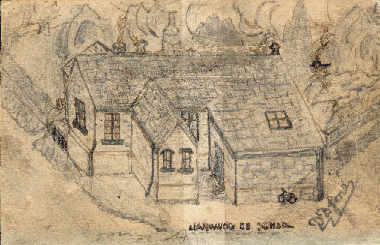
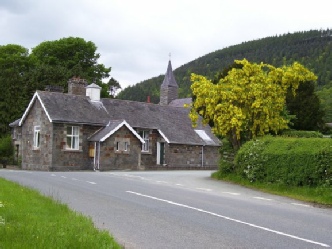
Wingate took two mission to Burma. Following the first (Operation Longcloth) in 1943, his Chindit force was expanded and flown in a second time in March 1944 (Operation Thursday). The 1st Battalion South Staffordshire Regiment formed one of the six brigades utilised for Operation Thursday. My uncle’s battalion was part of 77th (Indian) Infantry Brigade nicknamed EMPHASIS under the command of Brigadier J Michael (“Mad” Mike) Calvert DSO.
EMPHASIS comprised : -
3rd Bn 6th Gurkha Rifles: 36 and 63 columns
1st Bn The King’s Regiment: 81 and 82 columns
1st Bn The Lancashire Fusiliers: 20 and 50 columns
1st Bn The South Staffordshire Regiment: 38 and 80 columns
3rd Bn 9th Gurkha Rifles: 57 and 93 columns.
The Battalion CO was Lt-Col. G. P. Richards MC The Battalion formed two columns; 38 under Lt-Col Richards, and after his death, Major W A Cole MC, and 80 column under Major, later Col, R Degg. The battalion was flown into the Broadway landing ground at the beginning of March, and moved to White City mid March, marching out on 30 March. The columns were combined in mid May and the battalion pulled out in July.
A covering note in the war diary says “It will be realised that the field returns are in the majority of cases not accurate, owing to the type of operations” which could refer to the harsh conditions under which the second Chindit expedition was fought.
In a letter from Lt-Col R Degg to General Wavell dated 30 July 1944 he says : -
………………… We landed at Broadway then commenced to make our way to our objectives. This was carried out successfully and a block formed on the Road and Rail communications at HENU, later known as White City: that was our task and we completed it. This is in the Mogaung - Indaw Valley; hard and bitter fighting ensued for over 6 weeks in and round this fortress. All attacks were repulsed and we made several attacks outside and during the forming of the Block. It was in one of these actions that Col Richards was killed………………. He was excellent and a great and inspiring leader, one of which the Bn is very proud of, and sorry to lose, and the Regt lost one of its most gallant and loyal officers when Col. Richards died of wounds. After holding these positions for several weeks the Bde was then ordered to capture MOGAUNG.
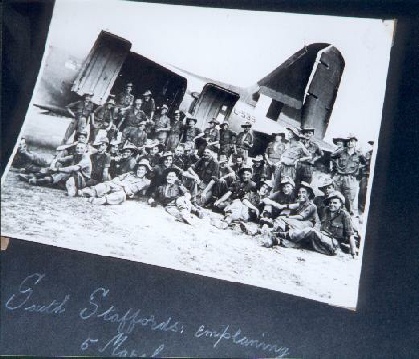 This task entailed scaling mountains several times over 4500 ft before reaching
its objective; the Bn fought and marched under the most appalling conditions but
they did it well, at times they fought in waist deep water, others clearing mountain
tops. These conditions were some of the hardest British troops have ever been called
upon to fight in. The last 6 weeks before the capture of MOGAUNG, the Bn was always
in close contact with the enemy, fighting him every day. In every action we inflicted
heavy casualties and never once did we fail in an attack, neither did we lose ground
that we captured. This in itself was a grand demonstration of guts and determination
by the Bn. There are lots of stories of bravery I could relate to you but I feel
those would come better in the official documents and diaries. Yours sincerely (sd)
R. Degg.
This task entailed scaling mountains several times over 4500 ft before reaching
its objective; the Bn fought and marched under the most appalling conditions but
they did it well, at times they fought in waist deep water, others clearing mountain
tops. These conditions were some of the hardest British troops have ever been called
upon to fight in. The last 6 weeks before the capture of MOGAUNG, the Bn was always
in close contact with the enemy, fighting him every day. In every action we inflicted
heavy casualties and never once did we fail in an attack, neither did we lose ground
that we captured. This in itself was a grand demonstration of guts and determination
by the Bn. There are lots of stories of bravery I could relate to you but I feel
those would come better in the official documents and diaries. Yours sincerely (sd)
R. Degg.
The war diary entry for 11 June; the day of my uncle’s death reads : - Bn moved up at first light and collecting the coy left SOUTH of the road, met the enemy in strength at NATGYIGON at about 1300 hrs. The enemy were attacked and the SOUTH EAST corner of the village was taken but the enemy counter-attacked and the battalion withdrew about 600 yds for the night.
There was no enemy action during the night. Casualties from action on 11th - Own cas 16k 12w - Enemy cas 15k. This appears to be the action in which my uncle David Jones was killed.
The diary includes a battle casualty list for the month, which includes the entry “14639680 Pte Jones. D.” under “killed”. The casualty list shows a total of 6 officers and 62 other ranks killed, including one attached Royal Engineer. 16 other ranks died of wounds and one other rank died of sickness.
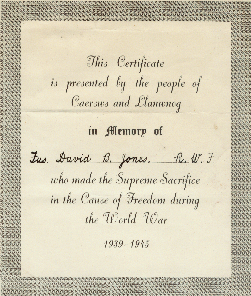 In his book “Prisoners of Hope” Michael Calvert describes one of the combats on
11 June thus : -
In his book “Prisoners of Hope” Michael Calvert describes one of the combats on
11 June thus : -
“At the same time as the Lancashire Fusiliers attacked I had sent the Staffords towards the north to clear the area from the road to the river so that our right flank at least would be secure. They had a hard time. They avoided the obvious path, but, thinking of their previous success, ploughed and cut their way through the swamps, covering four times as much ground as they need have done. As they emerged, tired and exhausted, into the open near the river-bank, they were engaged by a well-entrenched enemy. The Staffords atacked, but in spite of making some progress, they could not hold their ground”. In a letter written just before Christmas 1945, Brigadier Calvert said about South Staffordshire Regiment "I can say that I never have I seen or fought with such a good battalion as the 1st Bn South Staffordshire Regiment".
"The only reason why, during the first days' fighting around HENU, none of the 1st Bn received a VC, was first because our original citation perished with Gen Wingate, and secondly because we were too busy fighting to have much time to think about that then. I realise that the victories we achieved were to a great a degree, due to their steadfastness, will to win, & the magnificent fighting spirit and sound organisation of the 1st Battalion The South Staffordshire Regiment".
The memorial to Private 14639680 David Bennett Jones stands in TAUKKYAN (pronounced Tauchan), the largest of three War Cemeteries in Myanmar (formerly Burma) just outside Yangon (formerly Rangoon). The reference number is 13. K. 23.
Memorials at the National Memorial Arboretum, Lichfield, Staffordshire, England
Pictures Page 1 - A random selection of pictures relating to Private David Jones.
Documents - Series of documents from 1940s relating to Private Jones.
Burma Visit 2003 including pilgrimage to grave reference number 13. K. 23.
Website of the Burma Star Association
Picture of South Staffords emplaning 5 March 1944 courtesy of Staffordshire Regiment Museum, Lichfield.